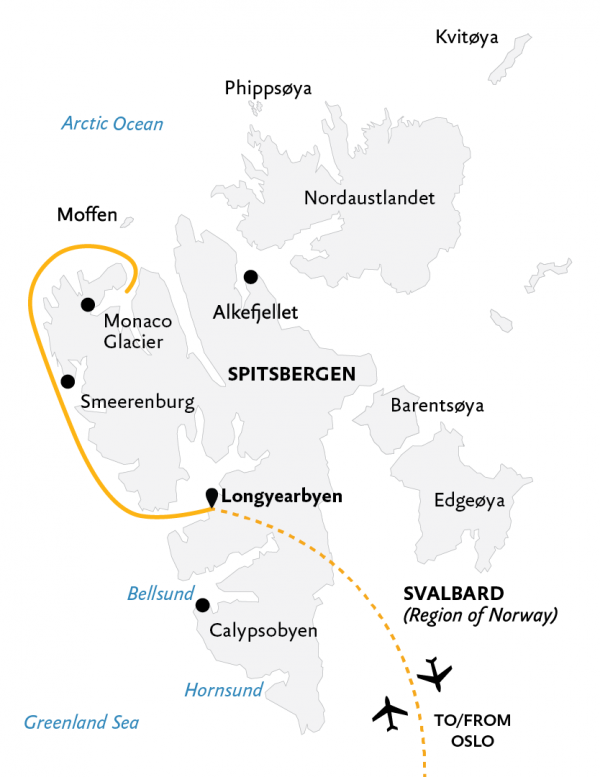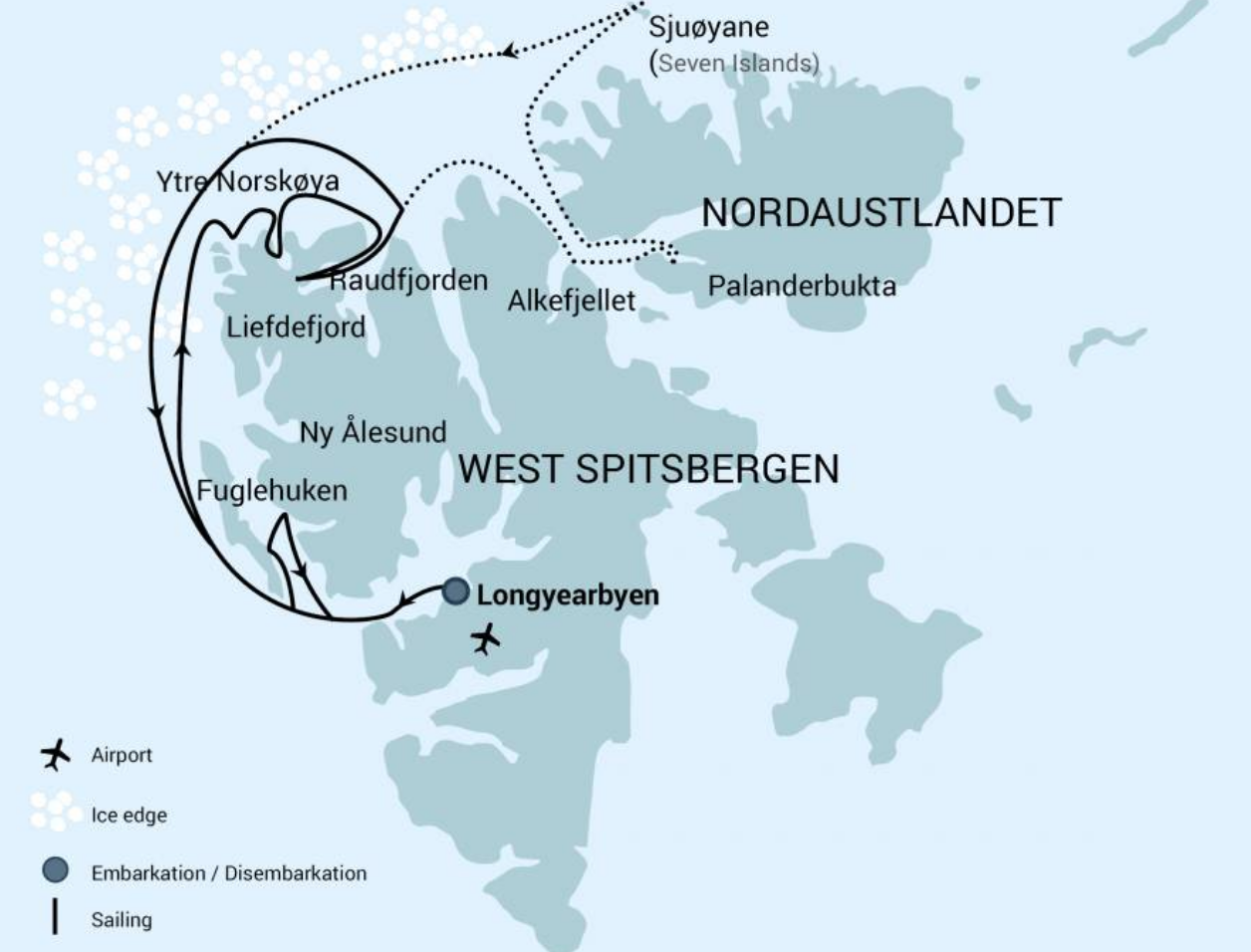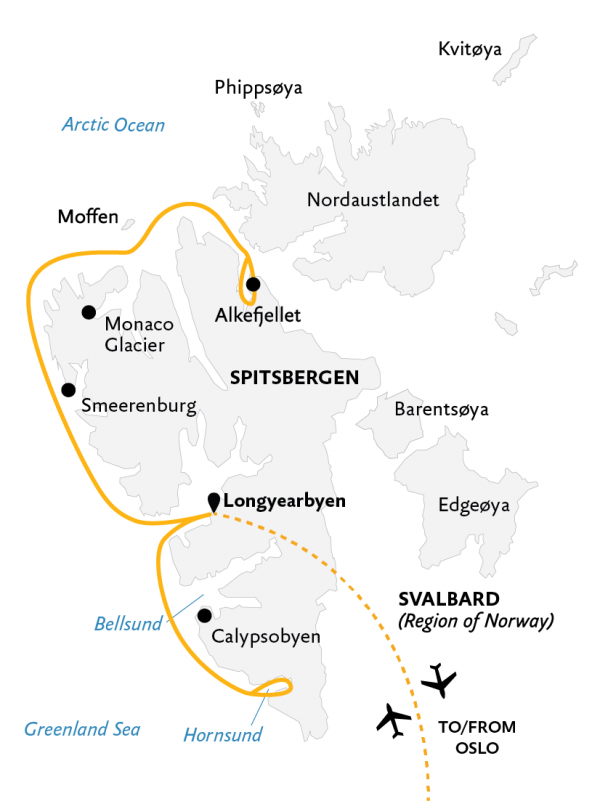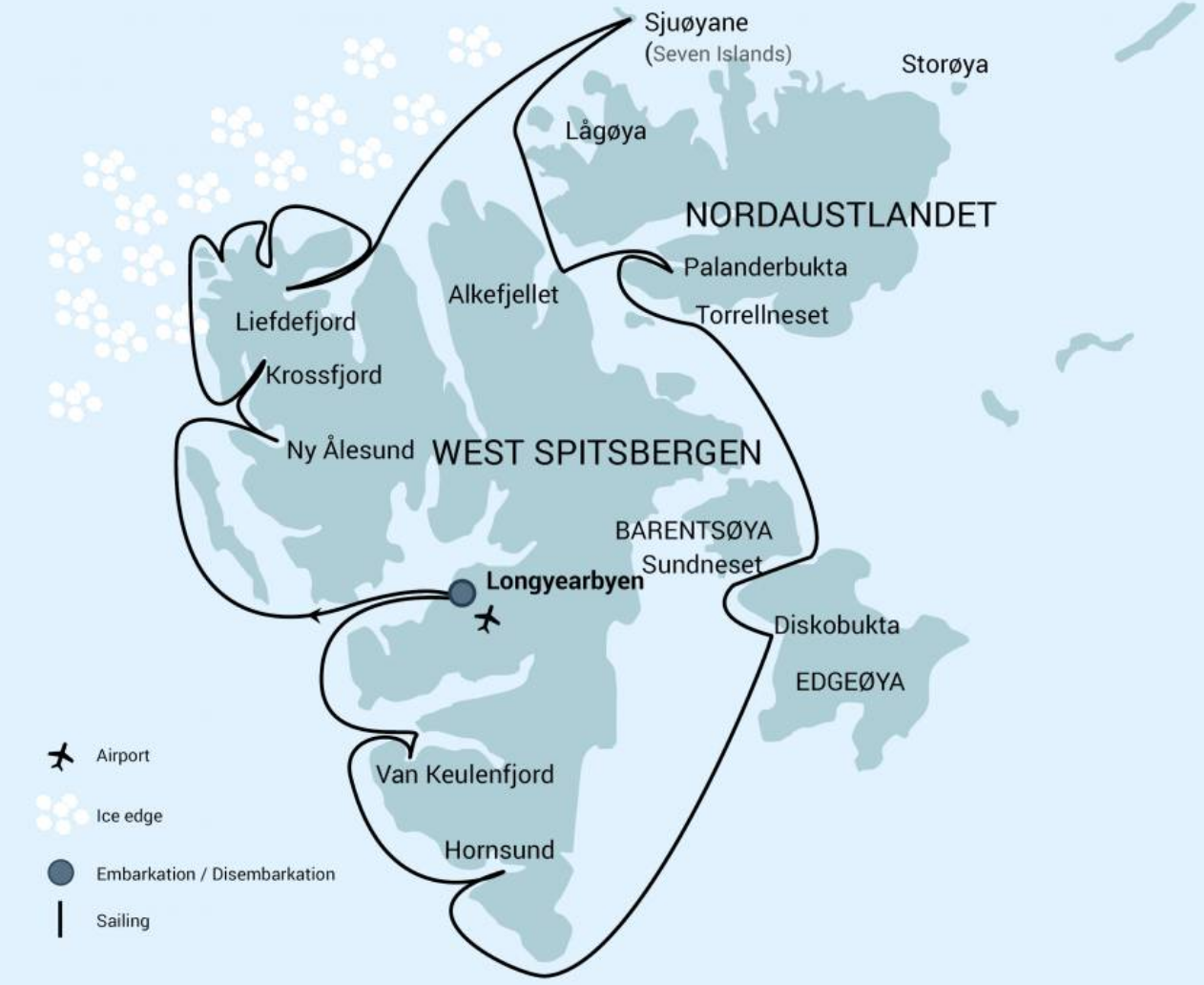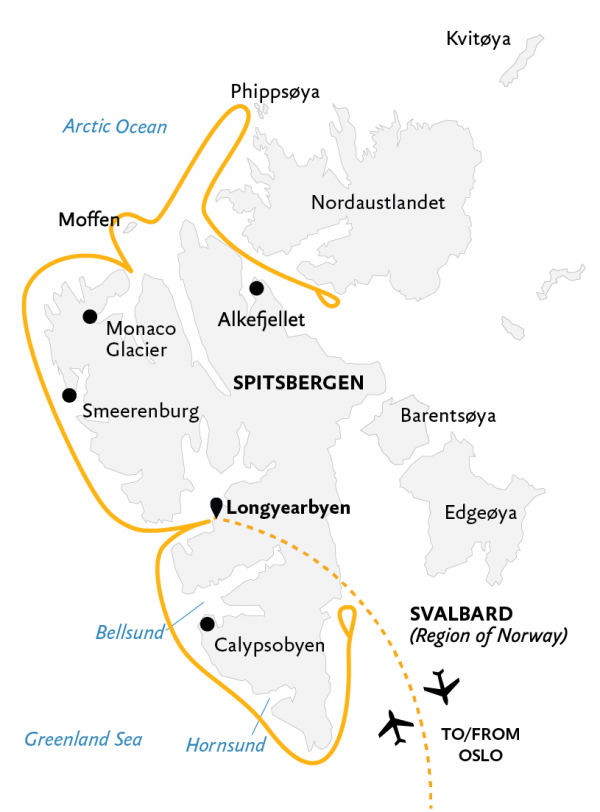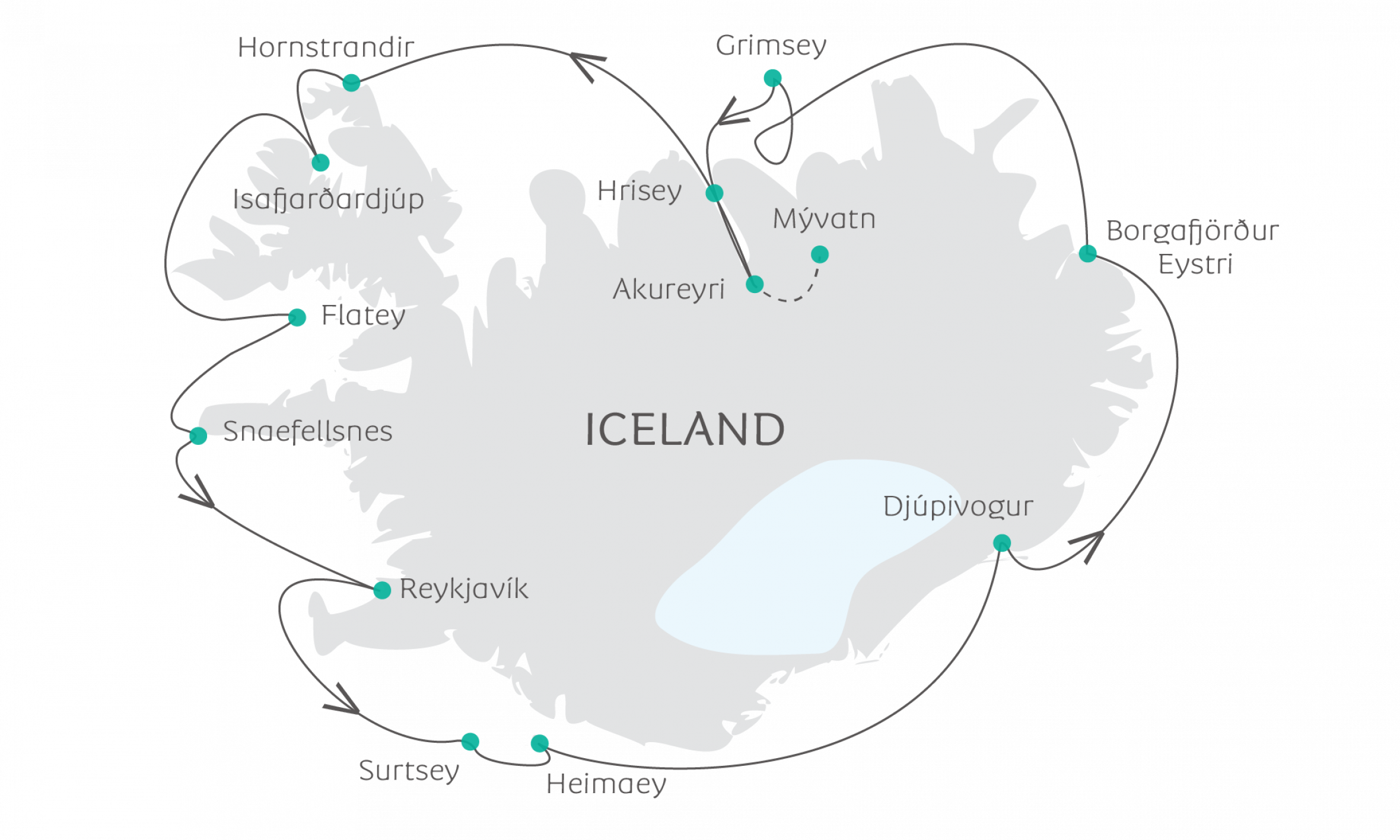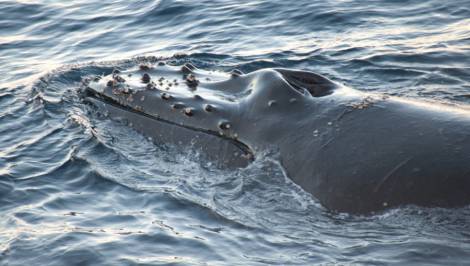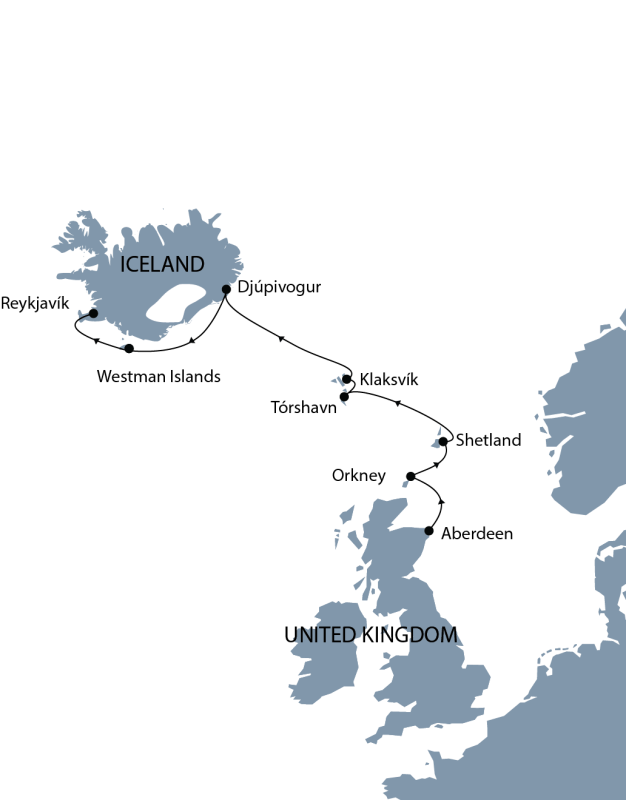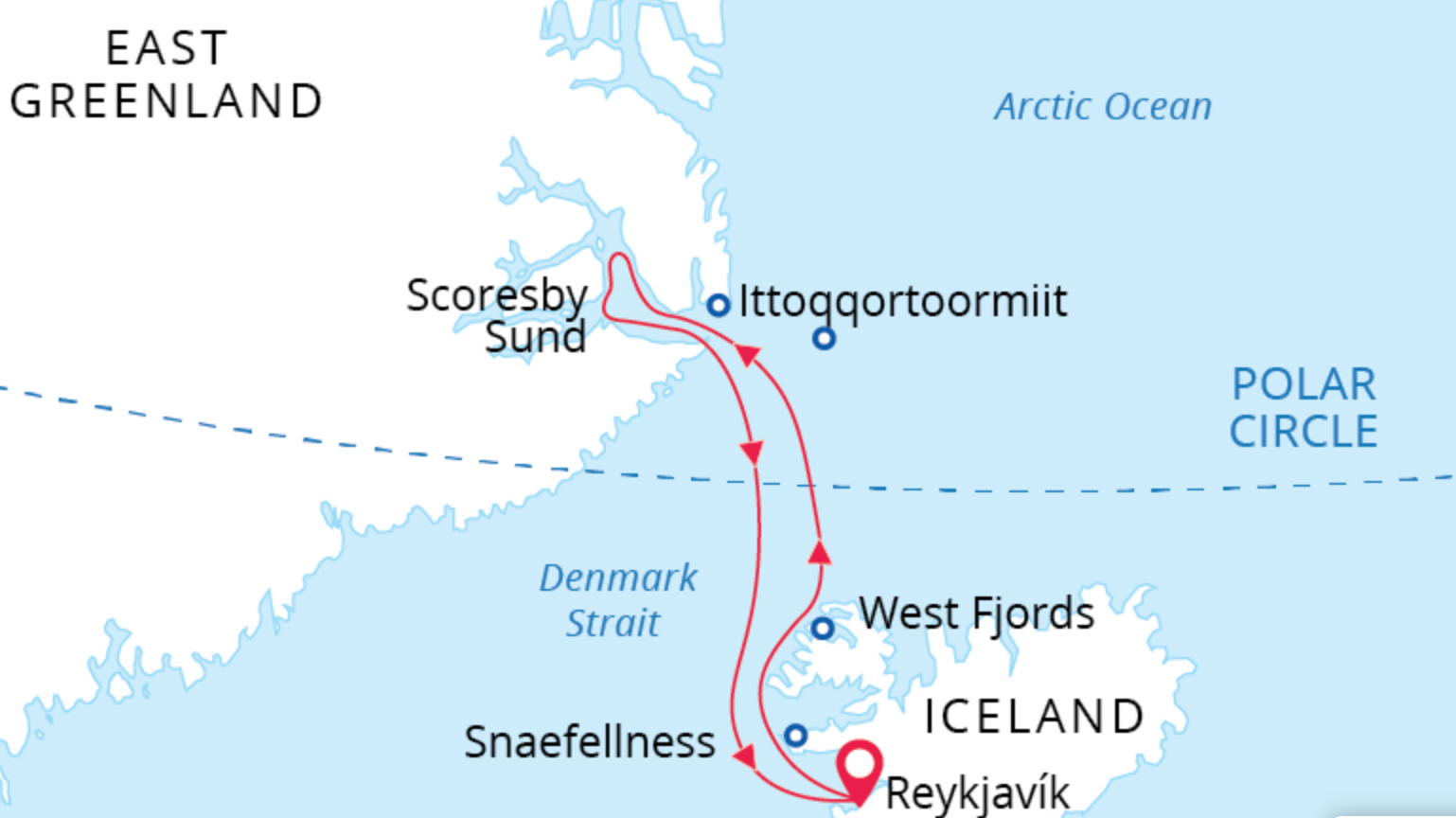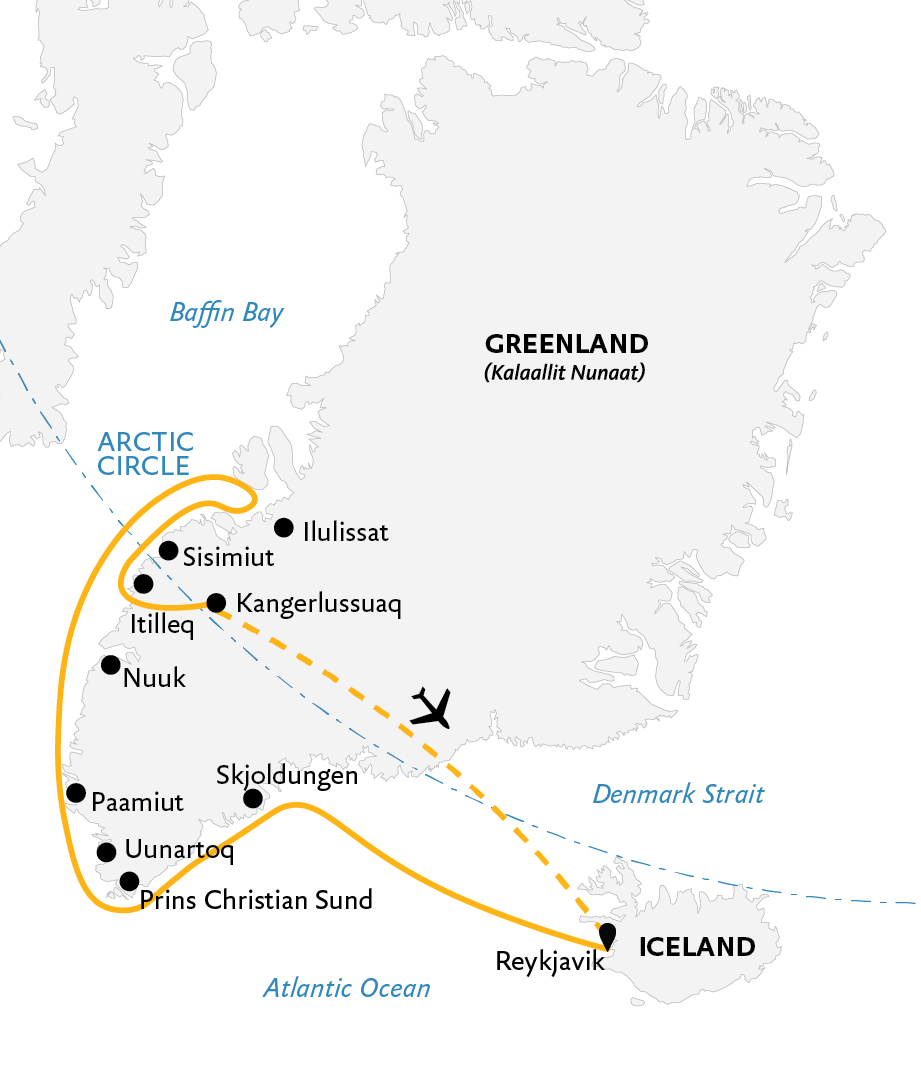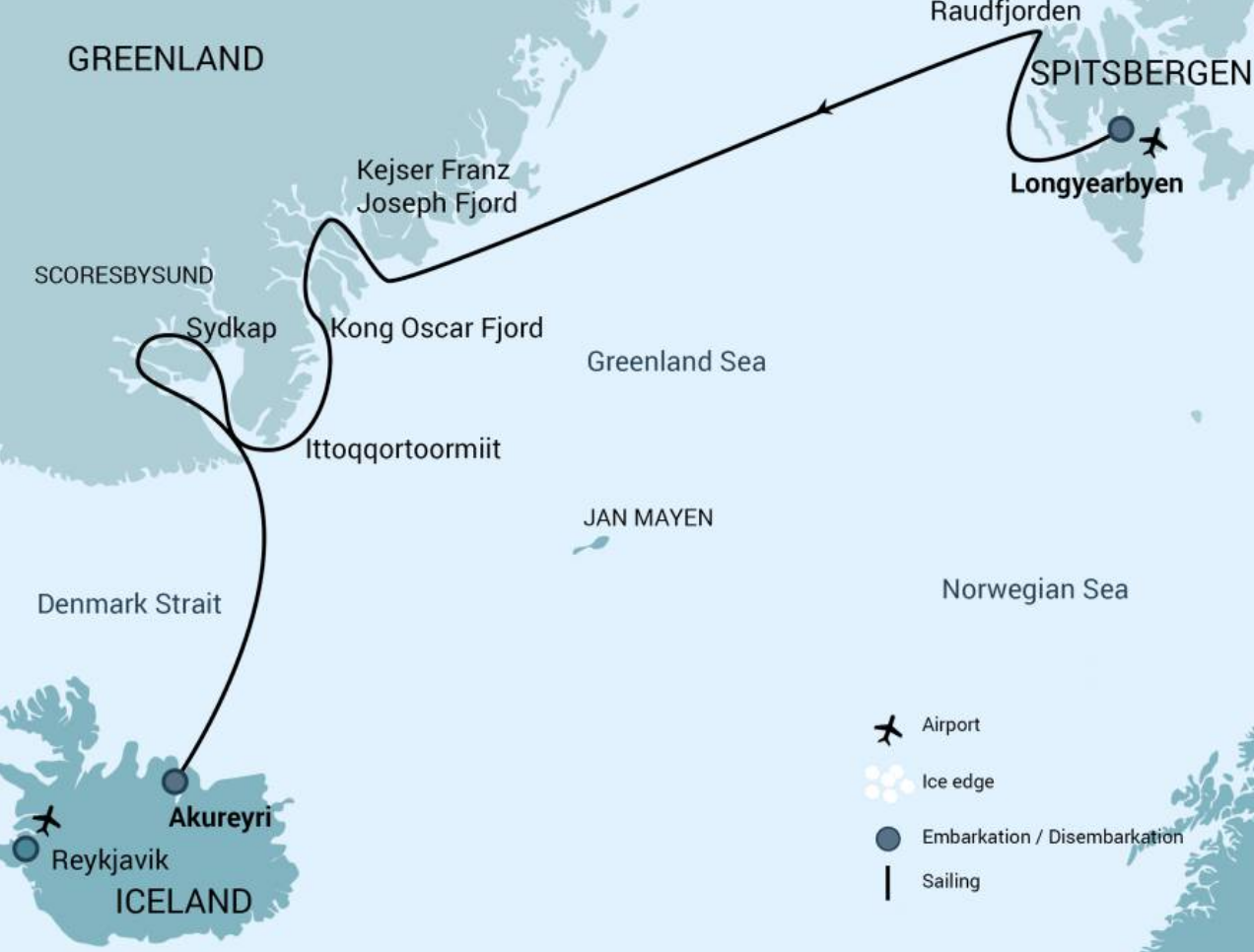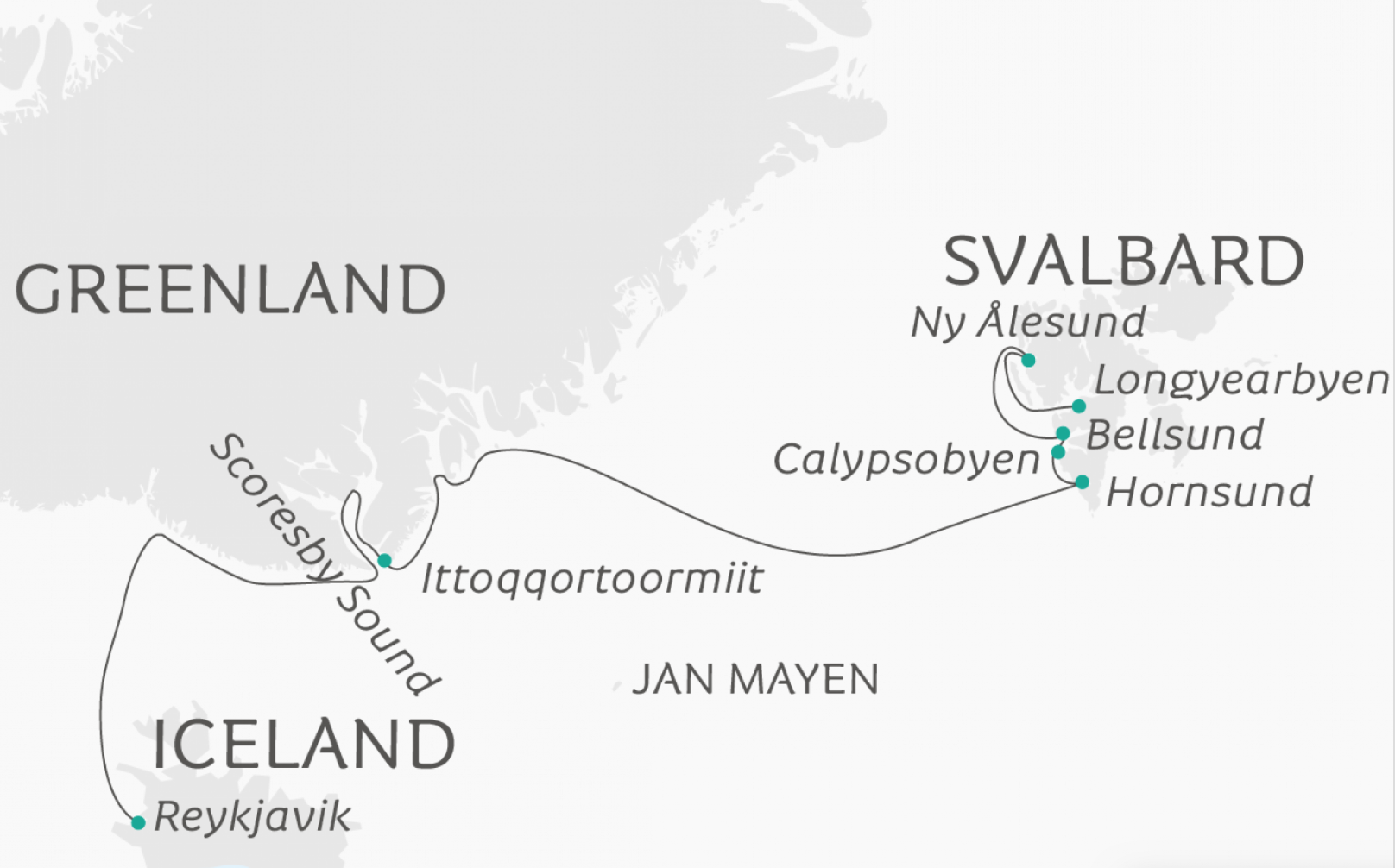The Arctic
The Arctic region encompasses a vast and awe-inspiring area, including the Spitsbergen, Greenland, Iceland, the Canadian Arctic, Alaska and the Russian Far East. The summer months of June to September offer the only time of the year when the ice retreats and travelers can witness the wildlife, scenery and cultures of the Arctic. Whether you are interested in learning about the history and exploration of the region, or want to go in search of the elusive polar bear, there is an itinerary for everyone.
In Greenland, prepare for majestic ice formations and interactions with the Inuit people. In Svalbard, spot polar bears, walruses, seals reindeer and arctic foxes. In the Canadian Arctic, sail farther north into the pack ice to experience endless ice.
Norwegian Fjords
Length of Travel: 13 days
Itinerary in Brief
- Day 1: Tromsø
- Day 2: Nordkapp
- Day 3: At Sea
- Day 4: Trollfjord/Lofoten Islands
- Day 5: Svartisen/Vikingen/Lovund
- Day 6: Vega/Torghatten
- Day 7: Trondheim
- Day 8: Eresfjord/Åndalsnes
- Day 9: Geirangerfjord
- Day 10: Ålesund
- Day 11: Shetland Islands
- Day 12: Orkney Islands
- Day 13: Edinburgh
* Special Notes
Reverse Itinerary
This trip also runs in reverse from Edinburgh to Tromsø.
Itinerary Map
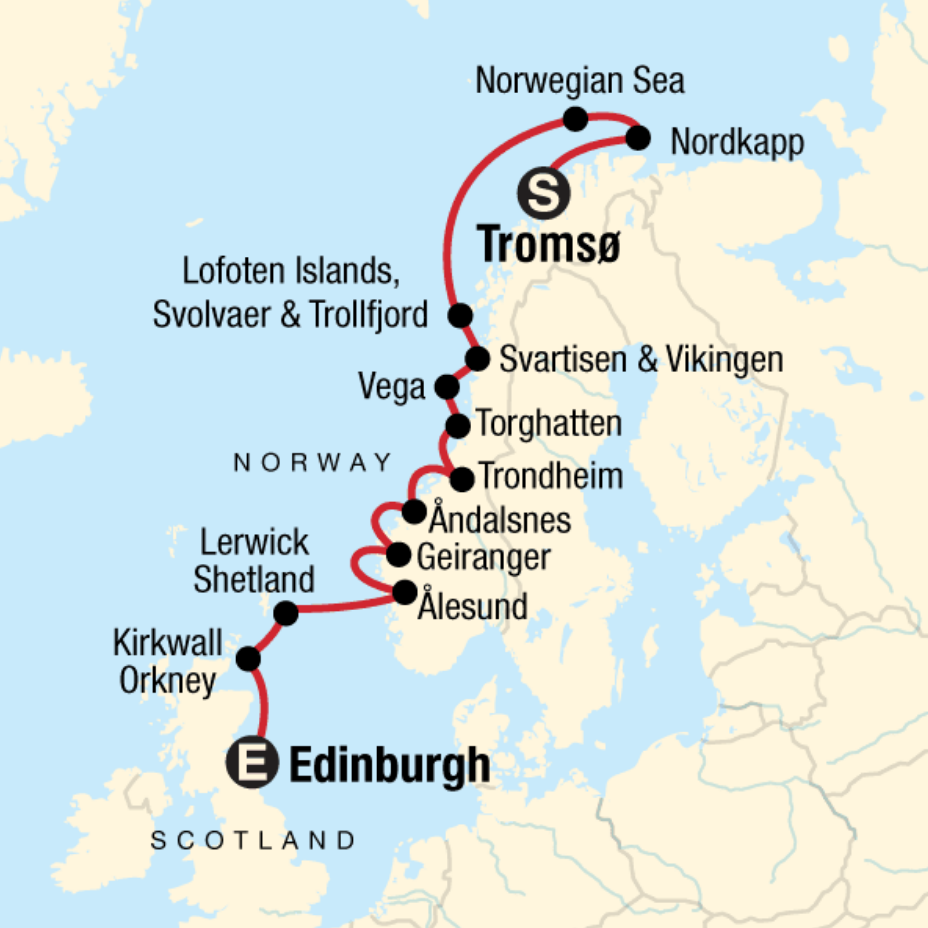
Detailed Itinerary
Day 1: Tromsø
Welcome to Tromsø, the capital of northern Norway, known as the “Gateway to the Arctic”. Embark in the afternoon. Consider arriving early to explore Tromsø.
Day 2: Nordkapp
Explore one of the most northern points in Europe. A popular spot to watch the midnight sun during the summer months, as the sun never sets between the middle of May to late August, this cape is the location where the Atlantic and Arctic oceans meet. Explore the barren landscape, quaint fishing villages, and stop by the Northern Cape Plateau standing 307 m above the sea.
Day 3: At Sea
Enjoy a day at sea, taking in the stunning scenery of the Arctic. Keep a sharp eye while on deck to try and spot marine wildlife.
Day 4: Trollfjord/Lofoten Islands
Spend the early morning at the short, yet dramatic Trollfjord. Try to spot the mythical creatures along the cliffs. Head ashore in Svolvaer to explore the Lofoten Islands by coach. Stop in Henningsvær for time to see local art or explore the quaint fishing village. After, visit Nusfjord, one of Norway’s oldest and best-preserved fishing villages for lunch at a local restaurant, before visiting the Tørrfiskmuseum to learn about traditional work of the islands. End the day in the town of Å.
Day 5: Svartisen/Vikingen/Lovund
Visit Svartisen, Lovund and Vikingen, for beautiful glaciers and a globe sculpture which marks Vikingen as a point directly on the Arctic Circle.
Day 6: Vega/Torghatten
The rugged coastline of central Norway features some of the world’s most beautiful scenery. Head to the quaint and picturesque Vega Island, a UNESCO site. Wander the fishing villages, go on a guided nature hike, and appreciate the slow pace of life. In the afternoon, hike up to the famous hole in the mountain, with fantastic views of the region. Keep an eye out for Norway’s mythical trolls.
Day 7: Trondheim
Continue on to Trondheim. Choose between hiking in Bymarka Nature Reserve before visiting the Sverresborg Folk Museum, or enjoying a city tour including the Folk Museum and the elaborate Nidaros Cathedral, built between 1070 and 1300. Enjoy a free afternoon to explore the area on your own.
Day 8: Eresfjord/Åndalsnes
Spend the morning exploring the town of Eresfjord or join an optional hike for amazing views. In the afternoon, board the Rauma Railway taking you into the dramatic scenes of the Romsdalen mountains.
Day 9: Geirangerfjord
Sail deep into one of Norway’s most beautiful, and most visited fjords, Geirangerfjord. Enjoy a coach tour to Dalsnibba, soaking in the views at this UNESCO World Heritage site. For the more adventurous, opt for a 10km mountain hike exploring the area and taking in amazing views of the fjord from above. If possible, the Expedition ship will cruise around this scenic area.
Day 10: Ålesund
Spend the morning exploring the beautiful Art Nouveau district of Ålesund, or take the 418 steps up to Fjellstua for the views of the city, islands and bay. Opt to visit the Ålesund Museum and learn about the culture and history of the town, including the fire which destroyed the city in 1904. If you are feeling more active, try one of the local hikes for unbeatable views.
Day 11: Shetland Islands
Continue southwards to the remote Shetland Islands. Opt to visit Jarlshof or join the Puffin Bus to focus on puffins and seabird photography at Sumbrugh Head (weather dependent). Enjoy additional time to explore Lerwick.
Day 12: Orkney Islands
Visit historic and mystical sites by coach on this remote island. Explore the Standing Stones of Stenness, the intriguing Ring of Brodgar, and the village of Skara Brae.
Day 13: Edinburgh
Cruise overnight to Edinburgh’s Port of Leith, then disembark the G Expedition in the morning. It’s highly recommended to book extra time to visit Edinburgh.
Franz Josef Land in the Russian High Arctic
Length of Travel: 14 Days
Itinerary in Brief
Day 1: Longyearbyen, Svalbard
Day 2: Embarkation in Longyearbyen
Days 3 & 4: Across the Barents Sea
Days 5 to 11: Exploration of Franz Josef Land
Days 12 & 13: Back to Svalbard
Day 14: Disembarkation in Longyearbyen, Svalbard
Detailed Itinerary
Day 1: Longyearbyen, Svalbard
Welcome to Longyearbyen, the administrative capital of the Norwegian territory of Svalbard and starting point of our expedition. After arriving via scheduled commercial flight service, you are free to explore this fascinating Arctic settlement. Be sure to see the excellent Svalbard Museum and take advantage of quality shopping and dining opportunities in the town center. Your hotel for the night has been arranged by us and is included in the price of the voyage.
Day 2: Embarkation in Longyearbyen
In the afternoon we welcome you aboard the luxury expedition ship M/V Sea Spirit. Explore the ship and get comfortable in your home away from home for the extraordinary adventure to come. Savor the anticipation of your Arctic dreams coming true as we slip our moorings and sail into a true wilderness where wildlife abounds. The scenery as we sail through Isfjorden on our first evening is spectacular and there is already the possibility of marine mammal encounters.
Days 3 & 4: Across the Barents Sea
From Isfjorden we proceed forthwith around Svalbard and east to Franz Josef Land across the Barents Sea. Presentations and workshops by our expert staff prepare us for what lies ahead.
In these far northern latitudes it is possible to encounter sea ice any time of the year. All along the way we remain vigilant for sightings of ice-dependent marine mammals such as the elusive bowhead whale, various Arctic seal species, and the majestic polar bear.
Days 5 to 11: Exploration of Franz Josef Land
This is expedition cruising at its most authentic. As such, our route and exploration opportunities in Franz Josef Land are heavily dependent on weather and sea ice. Our experienced captain and expedition leader decide our best route and continually adjust plans as opportunities warrant in this wild and remote corner of the Arctic.
Between obligatory initial and final calls at the Russian polar station Nagurskoye in wildlife-rich Cambridge Bay, we are free to explore the many waterways and islands of this unique Arctic wilderness.
The archipelago, part of the Russian Arctic National Park since 2012, is a nature sanctuary. Polar bears and other quintessential High Arctic wildlife—such as walruses and some rare whale species—can be spotted anytime, anywhere in and around Franz Josef Land. Scree slopes and cliffs around the islands host enormous nesting colonies of migratory seabirds such as guillemots, dovekies, and ivory gulls. We’ll take advantage of the 24-hour daylight to exploit every opportunity for wildlife viewing.
Franz Josef Land is also home to some interesting geological features, such as the mysterious stone spheres on Champ Island. Collectors of geographical extremes may take note that Cape Fligely on Rudolf Island is the northernmost point of land in the Eastern Hemisphere.
Franz Josef Land also offers visitors the opportunity to walk in the footsteps of famous polar explorers at well-preserved historical sites. The journals of explorers such as Julius von Payer, Benjamin Leigh Smith, Frederick George Jackson, and Fridtjof Nansen come alive at Cape Norway, Cape Flora, Eira Harbor, and Cape Tegetthoff. Memorials, monuments, crosses and the remains of dwellings are testimony to incredible historical events that are further illuminated by our expert lecturers.
Tikhaya Bukhta is currently a Russian Arctic National Park ranger station occupying Soviet-era research buildings and was also a major base for polar expeditions. Nearby the fascinating columnar basalt cliffs of Rubini Rock are home to thousands of nesting seabirds.
Days 12 & 13: Back to Svalbard
Following our week of exploration in Franz Josef Land, we cross back through the bountiful waters of the Barents Sea and then along the coastal islands of the Svalbard Archipelago. From panoramic open decks, enjoy Arctic landscapes and wildlife sightings. On ice floes and on fast ice, several species of seals watch vigilantly for polar bears, which can be spotted anytime, anywhere in and around Svalbard. Bountiful inshore and offshore waters are home to walrus and a wide variety of whales.
The crossing also gives our expedition team the opportunity to offer a final presentation or two in the Oceanus Lounge.
Day 14: Disembarkation in Longyearbyen, Svalbard
After breakfast we say farewell in the town of Longyearbyen, where we started. We provide a transfer to the airport or to the town center if you wish to spend more time here. As you look back on your wonderful experience in Svalbard, you may already be looking forward to your next incredible adventure to the ice!
Canadian Arctic
Length of Travel: 20 Days
Itinerary in Brief
Day 1 — Arrive in Reykjavik, Iceland
Day 2 — Embarkation Day in Kangerlussuaq, Greenland
Day 3 — At Sea
Days 4 to 6 — Exploring Baffin Island, Canada
Day 7 — At Sea
Days 8 to 11 — Lancaster Sound
Day 12- Smith Sound
Days 13 and 14 — Exploring Northwest Greenland
Day 15 – At Sea
Days 16 to 18 — Exploring West Greenland
Day 19 — Disembark in Kangerlussuaq and Fly to Reykjavik
Day 20 — Depart Reykjavik, Iceland
* Special Notes
All itineraries are for guidance only. Programs may vary depending on ice, weather, and wildlife conditions. Landings are subject to site availabilities, permissions, and environmental concerns per AECO regulations. Official sailing plans and landing slots are scheduled with AECO prior to the start of the season, but the expedition leader determines the final plan. Flexibility is paramount for expedition cruises.
Itinerary Map
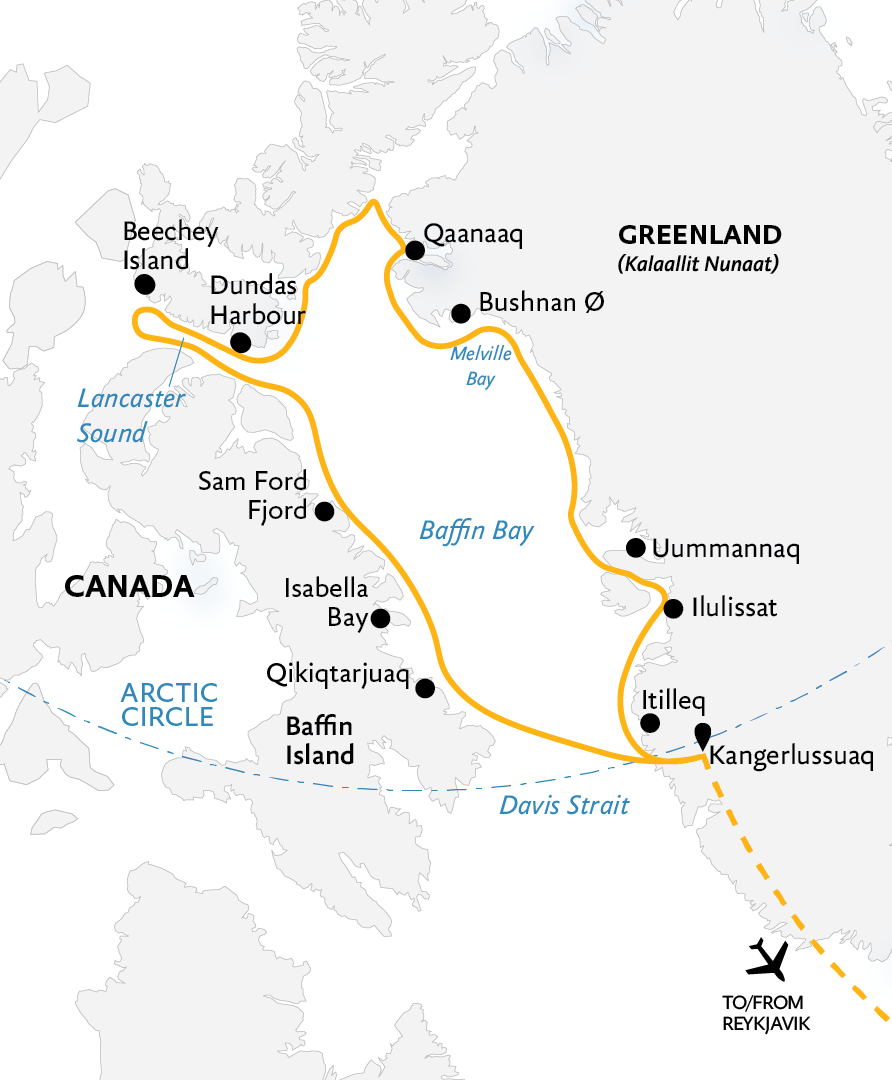
Detailed Itinerary
Day 1 — Arrive in Reykjavik, Iceland
Your Arctic expedition begins in Reykjavik. Explore Iceland’s capital city on your own before spending the night at your included hotel.
Day 2 — Embarkation Day in Kangerlussuaq, Greenland
In the morning, the group will transfer to the airport and board our private charter flight to Kangerlussuaq, a small town at the eastern head of Sondre Stromfjord, one of the longest fjords in the world. After embarking your ship in the afternoon, enjoy time out on deck, taking in your new surroundings as you set sail on your arctic expedition.
Day 3 — At Sea
As we cruise across the Davis Strait, your Expedition Team will prepare you for the adventures that await. Learn about the storied history and politics of the Arctic, its fascinating wildlife, geology, ecology and climate, and the incredible sights you will soon explore. Staff will also keep a lookout for seabirds soaring above your ship, as well as whales that frequent the waters here.
Days 4 to 6 — Exploring Baffin Island, Canada
Baffin Island is the fifth-largest island in the world, it was named for English navigator William Baffin, who ventured to the area in the early 17th century in search of the fabled Northwest Passage. Your days sailing along the island’s eastern coast will be guided by weather and ice conditions, with each day and each landing presenting new adventures. Some of our favorite destinations include Qikiqtarjuaq, Isabella Bay and Sam Ford Fjord. Towering mountains, deep fjords, colorful tundra, and Inuit settlements await!
The Inuit community of Qikiqtarjuaq (which means “the big island” in Inuktitut) is located just north of the Arctic Circle, on Broughton Island. Fondly called Qik by locals, the welcoming hamlet offers a superb vantage point of the Davis Strait. You’ll also have a chance to support local Inuit artisans here by purchasing unique artwork, crafts and jewelry.
The rarely explored Sam Ford Fjord is one of the most isolated places on the planet. It is a spectacular big-wall playground, attracting adventurous climbers eager to scale the dozens of towering vertical granite cliffs that erupt from the sea. Have your camera handy as you cruise along this impressive coastline carved by ancient glaciers—the towering formations, stacked side by side, are simply majestic.
Day 7 — At Sea
As our ship sails farther north, take in a presentation by our on-board experts, sip an icy cocktail in the bar, watch a movie or join your Expedition Team on the bridge as they scan for wildlife—there is no shortage of activities while at sea.
Days 8 to 11 — Lancaster Sound
The gateway to the Northwest Passage, Lancaster Sound is one of the richest marine habitats in the Arctic. With open-water areas staying ice-free all year, it is an important summer feeding area for whales and other marine wildlife. Our days here will be spent exploring several of the sound’s beautiful bays and inlets, discovering historical sites, enjoying Zodiac cruises and searching for such iconic wildlife as walrus, seals and, of course, whales. Polar bear sightings are possible too, as Lancaster Sound is known for polar bear sightings. If you’re fortunate, you may even spot the elusive narwhal.
There may be a possibility for a shore visit at Radstock Bay, the location of one of the most impressive ancient Thule sites in the Arctic. Exploring the well-preserved remains of the subterranean houses, including the whale bones used as supports for the dwellings, will give you an understanding of how these pre-Inuit people thrived in the Far North.
We will attempt to land at Beechey Island, a Canadian National Historic Site. Named after explorer Frederick William Beechey, the island is the final resting place of members of Sir John Franklin’s 1845–46 expedition to find the Northwest Passage. The graves, on a desolate rocky beach, were discovered in 1850 by a team searching for signs of the ill-fated expedition.
Predominantly covered in glaciers and ice fields, Coburg Island and its surrounding waters comprise the Nirjutiqavvik National Wildlife Area. The island’s steep coastal cliffs are an ideal habitat for hundreds of thousands of nesting seabirds like Brünnich’s guillemots (thick-billed murres), black-legged kittiwakes, northern fulmars and black guillemots.
Day 12 — Smith Sound
Before saying goodbye to Canada, we’ll push as far north as possible, exploring both sides of Smith Sound, the uninhabited passage between Ellesmere Island and Greenland. Experience a true expedition as weather and ice determine how far north we explore.
Days 13 and 14 — Exploring Northwest Greenland
Your return to Greenland will have you sailing along the remote northwest coast, a land of impressive icebergs and massive glaciers. Qaanaaq, formerly known as Thule, is one of the northernmost towns in the world. Here, local Inuit share their culture and traditions, while the museum sheds more light on life near the top of the world.
We hope to explore Melville Bay, a significant whaling site until the early 1900s. Opening up to Baffin Bay, the area is a major egress for the Greenland ice cap and is home to spectacular icebergs in all shapes and sizes, making it an ideal spot for Zodiac cruising. If you’re feeling adventurous, perhaps you’ll treat yourself to a unique arctic experience by partaking in an optional paddling excursion (additional cost).
Day 15 — At Sea
As we continue sailing south along the west coast of Greenland, presentations by our on-board experts will prepare you for the adventures that lie ahead.
Days 16 to 18 — Exploring West Greenland
Boasting spectacular glaciers, mountainous landscapes, dramatic fjords and vibrant communities, the west coast of Greenland will leave you breathless. Some areas we hope to explore here are Uummannaq, Itilleq and the impressive Ilulissat Icefjord.
Quite possibly the most picturesque place in Greenland, the traditional Inuit town of Uummannaq (which means “heart-like”) takes its name from the red heart-shaped mountain that rises up a staggering 3,840 feet (1,170 meters) behind it. You’ll want to be positioned on deck as your ship approaches the shore, with your camera ready to capture the inspiring vistas of the twin peaks soaring high above the colorful houses dotting the rugged coastline.
Another beautiful locale is the Ilulissat Icefjord, a UNESCO World Heritage Site. Home to Jakobshavn, one of the most active glaciers in the world, this is a great spot to enjoy a Zodiac excursion past towering icebergs. Venturing ashore in the town of Ilulissat (which means “iceberg”) will allow you to visit the icefjord on foot and gaze at this unforgettable river of ice from the rocky shore.
Surrounded by sea and mountains, Itilleq (meaning “crossing place”) is situated about a mile (2 km) above the Arctic Circle, in a scenic hollow on a small island. It is the southern limit of the Greenlandic sled dog. To keep the breed pure, the dogs are not permitted south of this community and all other dog breeds are prohibited this far north. Explore the town’s traditional wooden houses painted in a rainbow of colors, chat with the locals, whose main trade is fishing, and maybe challenge them to a game of football (soccer) —it won’t be long before you’re experiencing Itilleq’s famous friendly vibe.
Day 19 — Disembark in Kangerlussuaq and Fly to Reykjavik
Enjoy one more Zodiac ride to shore, where you’ll board your charter flight back to Reykjavik, Iceland. Upon arrival in Reykjavik, we will transfer you to your included hotel.
Day 20 — Depart Reykjavik, Iceland
Today, you can make your way home at your leisure or spend time exploring this vibrant city.
North Pole
Length of Travel: 13-14 Days
Itinerary in Brief
Day 1: Stay in Helsinki, Finland
Day 2: Travel to Murmansk, Russia. Embarkation.
Days 3-6: Sail northbound to the North Pole*
Day 7: Arrive at the North Pole
Day 8: Sail southbound
Days 9-10: Explore
Days 11-12: Sail to Murmansk, Russia
Day 13: Disembarkation in Murmansk. Return to Helsinki.
Day 14: Depart Helsinki.
(13 day trips starts and ends in Murmansk)
* Special Notes
*AS A CONSEQUENCE OF THE WAR IN UKRAINE, NORTH POLE TRIPS ARE NOT OPERATING.
14 day trips- 2018 MANDATORY TRANSFER PACKAGE INCLUDES:
- One night’s pre- and post-expedition hotel accommodation in Helsinki with breakfast
- Round-trip flights from Helsinki to Murmansk (Additional USD 1895/person)
- Transfers to and from the ship
- Transfers between the airport and hotel in Helsinki
13 day trips- no added package mandatory
Travel to the North Pole can take anywhere from 5-8 days.
Itinerary Map
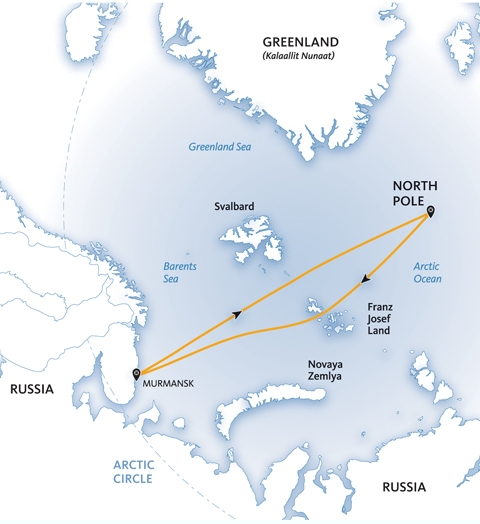
Detailed Itinerary
Day 1
Your adventure begins in Helsinki, Finland where you will spend one night.
Day 2
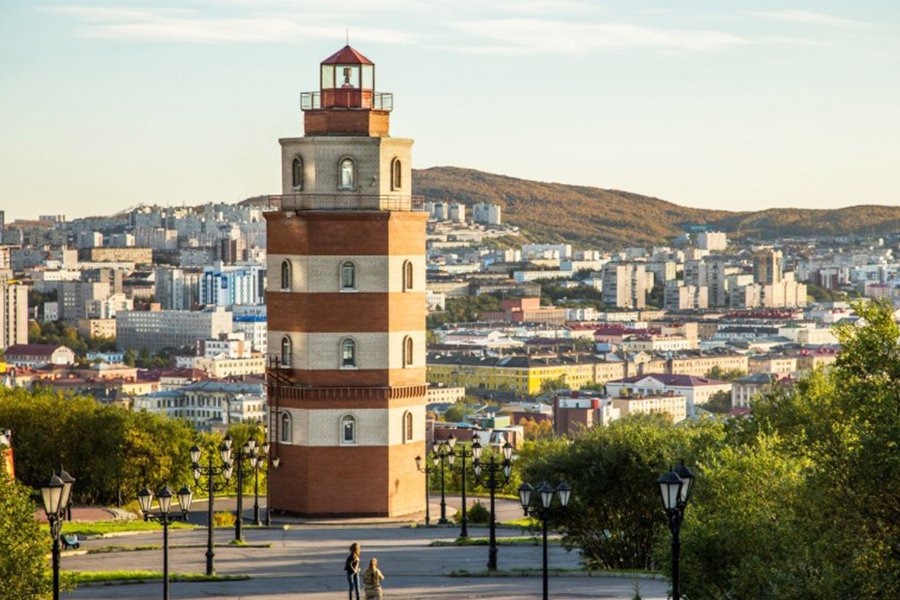
Today you will make your way from Helsinki to Murmansk, Russia via plane. Murmansk is Russia’s northernmost city. You will then become acquainted with 50 Years of Victory, an icebreaker ship that will be your home for the next 2 weeks as you journey to the North Pole.
Day 3-6
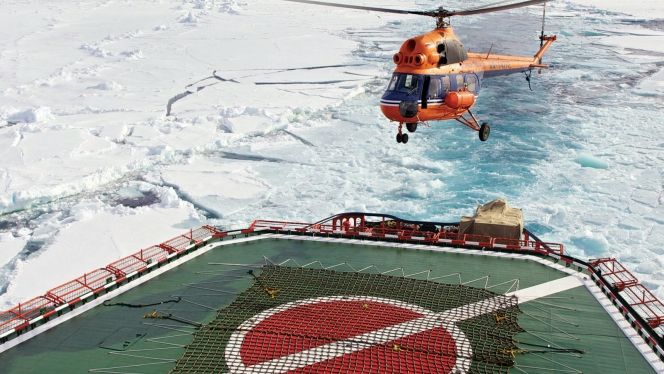
For the next several days you will make the crossing from Murmansk to the North Pole. The length of the crossing will vary based on weather conditions. During this part of your adventure you will have the time to use all of the ship’s amenities, chat with other passengers, and admire the scenery. If the weather allows, you can choose to hop aboard a helicopter and see the ship from above.
Day 7
Your expected arrival at the North Pole! You will be able to take plenty of photos and appreciate your time at 90˚North. You will celebrate your trip with a barbecue and, if you want, an Arctic plunge.
Day 8-10- Franz Josef Land
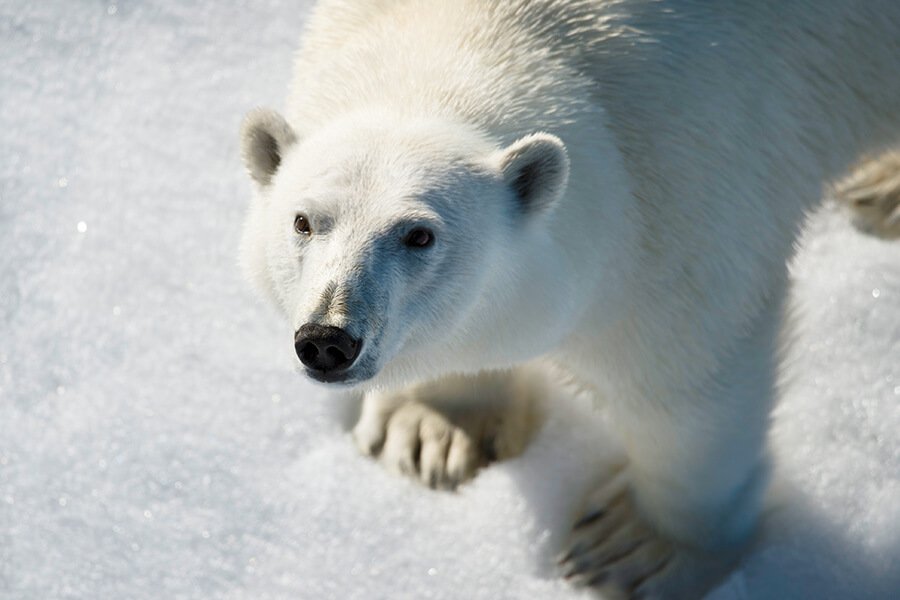
Enjoy your time at sea as you travel south. As time allows, you will check out Franz Josef Land, an archipelago of more than 190 island filled with glaciers and marine mammals including seals and whales. Your ship will have smaller zodiac boats which will allow you to explore the landscape up-close. These islands are remote and few people have had this unique opportunity.
Day 11-12
Continue to enjoy your time on the icebreaker as you make your way back to Murmansk. You can head to the ship’s gym or relax in the library.
Day 13
You will arrive in Murmansk and fly back to back to Helsinki for one final night with your shipmates.
Day 14
Sadly, your adventure comes to an end. You will fly out of Helsinki with memories of your time in the Arctic Circle.

